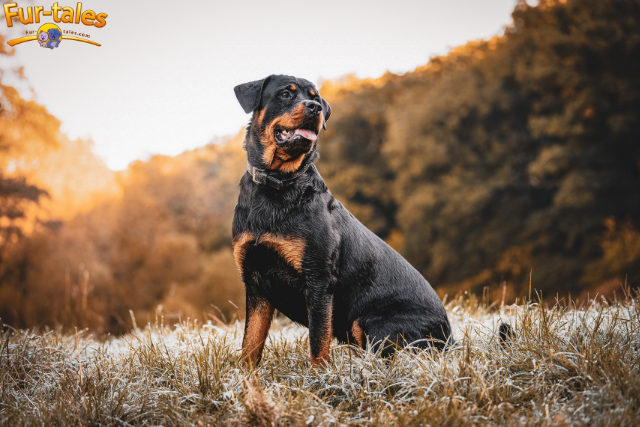
Rottweiler: The Complete Guide to This Powerful and Loyal Breed
When you think of a Rottweiler, strength, loyalty, and confidence are likely some of the first words that come to mind. These remarkable dogs have earned a reputation both as formidable protectors and as deeply devoted companions. But beneath their robust exterior lies a heart full of affection, intelligence, and an eagerness to bond with their family.
In this complete guide, we’ll explore the history, characteristics, care, training, and health of the Rottweiler, offering everything you need to know about this incredible breed.
The History of the Rottweiler
The Rottweiler’s history traces back to ancient Roman times. Roman legions traveling through Europe needed strong, intelligent dogs to herd livestock and guard supplies. The ancestors of today’s Rottweilers were descendants of these robust drover dogs.
When the Roman armies settled in what is now southern Germany, particularly in the town of Rottweil, these dogs became essential to the local economy. They earned the name “Rottweiler Metzgerhund,” meaning Rottweil butcher’s dog, because they helped herd cattle to market and pulled carts laden with butchered meat.
By the late 19th century, with the advent of rail transport and mechanization, Rottweilers’ working roles diminished. However, their intelligence, loyalty, and strength transitioned them into new roles — as police dogs, search and rescue dogs, and loyal companions.
Today, Rottweilers are known worldwide as one of the most versatile working breeds — excelling as service dogs, therapy dogs, and protective family pets.
Physical Characteristics
Rottweilers are built like tanks: muscular, solid, and athletic.
Size
- Males: 24–27 inches tall, 95–135 pounds
- Females: 22–25 inches tall, 80–100 pounds
They are considered a large to giant breed.
Coat and Color
- Coat: Short, dense, and straight
- Color: Black with clearly defined rust or mahogany markings on cheeks, muzzle, chest, legs, and beneath the tail
Their thick double coat offers weather resistance, though they’re not suited to extreme cold for prolonged periods.
Appearance
- Broad head, strong jaw, and a confident, watchful expression
- Muscular chest and sturdy legs
- Natural tails used to be docked (still seen in some areas), but most Rottweilers now sport full tails.
Temperament and Personality
Rottweilers are often misunderstood due to stereotypes, but responsible owners know them as loving, calm, and highly trainable dogs. Their most defining traits include:
1. Loyalty and Devotion
Rottweilers are famously loyal. They bond closely with their families and are especially affectionate toward “their people.”
2. Protective Instinct
Naturally protective without being unnecessarily aggressive, a well-socialized Rottweiler will act as a deterrent simply by presence alone but will step up bravely if a true threat arises.
3. Intelligence
Ranked among the top intelligent breeds, Rottweilers learn quickly and excel in obedience, agility, and even therapy work.
4. Confidence
A Rottweiler is confident, not fearful. They carry themselves with quiet assurance but are rarely aggressive without cause.
5. Gentleness
Despite their size, they can be incredibly gentle — often displaying surprising tenderness with children and smaller animals if properly socialized.
Important: Rottweilers require early and consistent training to grow into their best selves. Without guidance, their strong protective instincts can manifest as undesirable behaviors.
Training and Socialization
Rottweilers thrive with structured training and positive reinforcement.
Early Socialization
Expose them to a variety of people, places, sounds, and experiences during their first few months to prevent fearfulness or excessive suspicion later.
Obedience Training
Enroll your Rottweiler in puppy obedience classes by 8–12 weeks old. Focus on:
- Sit, stay, come
- Leash walking
- Recall under distraction
- Calm greetings with strangers
Leadership and Boundaries
Rottweilers respect calm, confident leadership. Inconsistent or timid handling can lead them to take charge in ways that aren’t ideal.
- Set clear rules early.
- Use firm but gentle corrections (never harsh punishments).
- Reward good behavior generously.
Mental Stimulation
They need mental challenges almost as much as physical exercise. Incorporate:
- Puzzle toys
- Scent work games
- Advanced obedience commands
- Agility training
Exercise Needs
Rottweilers are high-energy dogs requiring daily exercise to stay happy and healthy.
Aim for:
- 60–90 minutes of activity per day
- Walks, runs, or hikes
- Fetch games or tug-of-war
- Obedience drills
Lack of exercise can lead to boredom, which may cause destructive behaviors.
Note:
Because they are prone to joint issues (especially during growth stages), avoid over-exercising Rottweiler puppies. No forced running until they are at least 18–24 months old.
Grooming and Care
Rottweilers are relatively low-maintenance compared to many breeds.
Grooming Needs
- Brushing: 1–2 times per week to control shedding
- Bathing: Every 6–8 weeks, or when dirty
- Nail trimming: Every 3–4 weeks
- Ear cleaning: Regularly to prevent infections
- Dental care: Brush teeth several times a week
They shed moderately year-round, with heavier shedding twice a year during seasonal changes (spring and fall).
Health Issues and Lifespan
Like all breeds, Rottweilers are prone to certain health problems. Knowledgeable breeders test their dogs for genetic conditions.
Common Health Problems
- Hip dysplasia and elbow dysplasia (joint problems)
- Aortic stenosis (heart condition)
- Osteosarcoma (bone cancer)
- Progressive retinal atrophy (PRA) (eye disease)
- Bloat (gastric torsion, an emergency condition)
Lifespan
Typical lifespan: 9–11 years
With excellent care, some Rottweilers live longer — reaching 12 years or more.
Feeding Your Rottweiler
Nutrition plays a vital role in your Rottweiler’s health.
- Choose high-quality dog food with meat as the first ingredient.
- Avoid overfeeding, as Rottweilers are prone to weight gain.
- Feed appropriate portions based on age, weight, and activity level.
- Large breed puppy formulas are crucial to support slow, steady growth.
Divide meals into two daily feedings to help reduce the risk of bloat.
Living with a Rottweiler: Is It Right for You?
Owning a Rottweiler is a rewarding but serious commitment. They are best suited for owners who:
- Are willing to invest time in training and socialization
- Have a secure, fenced yard
- Are physically able to handle a strong dog
- Understand the importance of exercise and mental stimulation
- Can commit to consistent leadership
They may not be ideal for:
- First-time dog owners (unless working closely with a trainer)
- Families unwilling to commit to training
- Highly sedentary households
When raised with love, structure, and clear guidance, Rottweilers are exceptionally loyal family companions and gentle guardians.
Myths and Misconceptions
Rottweilers are often misunderstood due to media portrayals.
Truth:
- They are not naturally aggressive — poor breeding, lack of socialization, and improper training are usually to blame for any issues.
- A well-bred and well-raised Rottweiler is typically calm, confident, and loving.
- Rottweilers can be wonderful with children if raised with them and supervised properly.
Educating the public about responsible ownership is vital to improving the breed’s reputation.
Fun Facts About Rottweilers
- Bluey, the world’s longest-living Rottweiler, reportedly lived to age 15!
- They are one of the original police dogs and still serve in K-9 units worldwide.
- In Germany, Rottweilers must pass a temperament test to be officially registered.
- Despite their reputation, many Rottweilers are gentle clowns at home — loving belly rubs and couch cuddles.
Image Designed Using Canva
